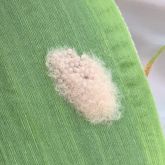Fall armyworm

Fall armyworm egg mass
© Melina Miles, Queensland Government

Larger larvae destroying a plant at night
© Melina Miles, Queensland Government

Female moth resting after a big night laying eggs in the corn at Ayr
© Melina Miles, Queensland Government

Large fall armyworm in a whorl
© Melina Miles, Queensland Government
Fall armyworm (FAW) reached the Australian mainland in early 2020. It has since spread across much of northern and eastern Australia. Research is underway to determine its likely impact and the most appropriate management approaches under Australian conditions.
A tropical migratory pest, FAW is expected to be present year-round in warmer areas, and for part of the year in temperate zones. Regions with sufficient periods of warm weather may be subject to local population build-up.
While FAW has a very wide potential host range, it has so far shown a distinct preference for grass species with whorls, including maize and sorghum.
Scientific name
Other names
- Whorlworm (international usage)
- Corn budworm (international usage)
- Maize budworm (international usage)
Description
Egg:
- less than 0.5mm in diameter
- egg clusters are usually covered in pale, 'furry' scales.
Larvae:
- up to 40mm long
- newly hatched larvae are translucent with a dark head capsule
- young larvae can vary from light green to brown
- older larvae develop lengthwise stripes, a pale 'Y' pattern on the head, and a set of prominent dark raised spots near the back end.
Pupae:
- reddish-brown
- about 15mm long
- usually found in soil below the host plant.
Adults:
- moths are nocturnal
- 16–17mm with a 32–40mm wingspan
- forewings are mottled in grey and reddish-brown
- males are more patterned than females.
May be confused with
- Egg masses look similar to those of the cluster caterpillar.
- Small to medium larvae have dark spots along the body similar to medium Helicoverpa larvae.
- The pale 'Y' on the head is also found on some other armyworm species.
- FAW pupae look similar to but are smaller than Helicoverpa pupae.
Distribution and habitat
Originating in the tropical and subtropical regions of the Americas, FAW is now found in Africa, the Indian subcontinent, China and South East Asia. This migratory pest can spread widely in some seasons but is likely to only survive year-round in warmer climates.
Hosts
FAW has been reported across a wide host range but appears to prefer grasses. The majority of damage in Australia so far has been to maize and sweet corn, with some damage to sorghum.
FAW also have the potential to infest various horticultural crops, pasture grasses and weeds. It has been recorded in sugarcane, cotton and wheat overseas, but there have been no significant reports of FAW in these crops in Australia so far.
Damage
Young larvae feed on the leaf surface, causing ‘windowing’.
In plants with whorls (such as maize and sorghum), larvae can enter the whorl and cause damage from the inside, resulting in ‘shot holes’ that become visible as the leaf unfurls. If the damage is severe, the upper leaf can detach.
Older larvae may also feed on roots and reproductive structures.
Life cycle
Eggs usually hatch in 3–5 days, and development through 6 instar stages to pupation takes 2–3 weeks.
Moths live for around 10 days, and a female can lay up to 1,000 eggs.
Monitoring and thresholds
Look for the egg masses and clusters of young larvae, and signs of leaf damage. Check in the whorl and around the plant base for larger larvae. Thresholds under Australian conditions are currently unknown, and will be a focus of future research.
Natural enemies
Several predators, parasitoids and pathogens of caterpillars currently present in Australia also attack FAW.
Current commercially available nucleopolyhedroviruses (NPVs) in Australia are specific to Helicoverpa and will not work on Spodoptera species; Biosecurity Queensland is researching the field efficacy of a Spodoptera variant of this virus.
Control
- Larvae that have burrowed into the plant can be difficult to reach with insecticides, so monitor regularly to identify infestations early.
- Pesticide permits for FAW are available in a range of field crops—details available through the Australian Pesticides and Veterinary Medicines Authority (APVMA).
- Biopesticide options are limited as NPV formulations for helicoverpa have no impact and larger larvae are difficult to control with Bt.
- Consider the potential for insecticide resistance (in both FAW and other species) when making product selections.
Further information
- Search for permits in the registered chemicals database at APVMA.
- Read more about identifying and managing FAW at the Beatsheet.
- Access the fall armyworm portal at the Grains Research and Development Corporation.
- View the national FAW continuity plan at Plant Health Australia.